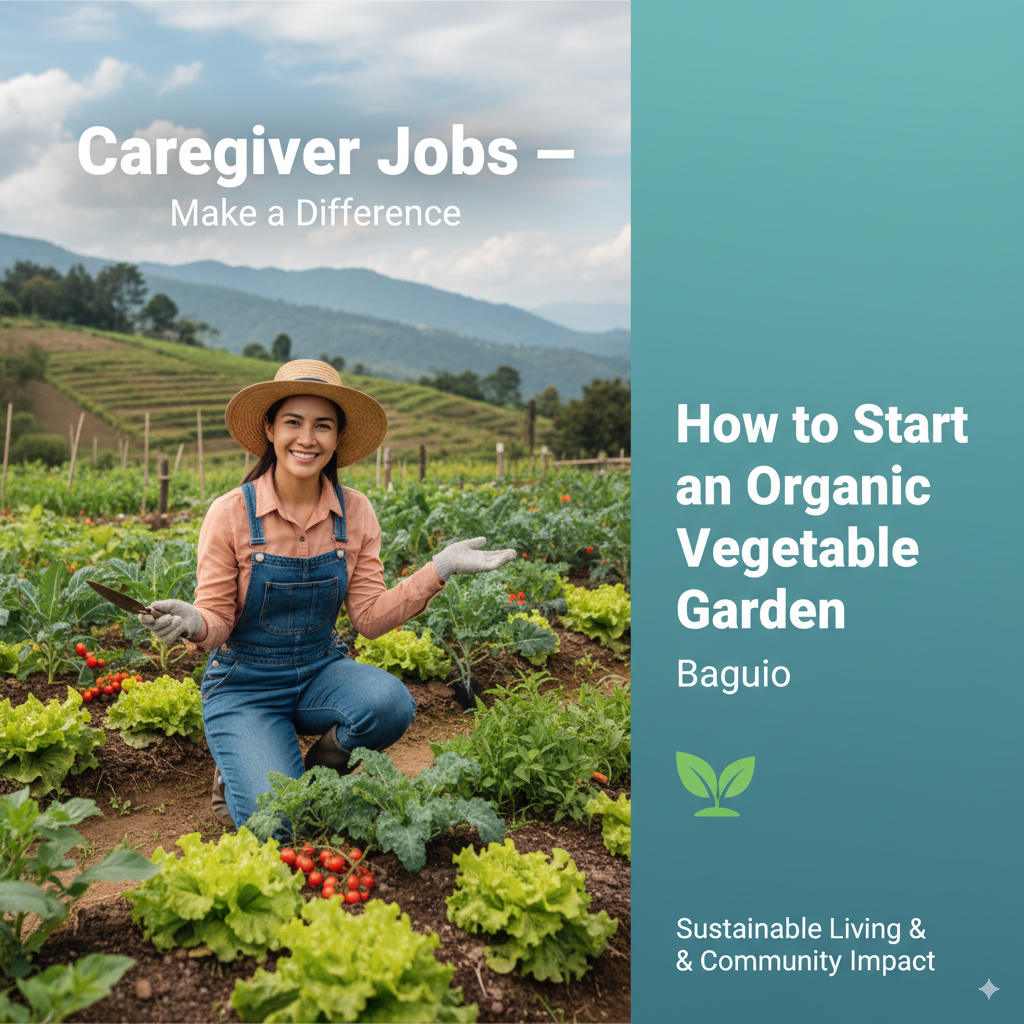Beginner’s Guide to Organic Vegetable Gardening in Baguio
If you’ve been searching for how to start organic vegetable garden Baguio you’re in the right place — this guide is written for first-time growers and small plot urban gardeners who want real, usable steps.
This practical article breaks down the essentials — site selection, soil and compost, cool-climate crop choices, organic pest control, and a planting plan — so you can get growing without guesswork. We’ll also point to local resources and simple weekly tasks.
Whether you have a balcony, a raised bed, or a 4×4 m backyard patch, learning how to start organic vegetable garden Baguio will help you produce tastier, safer food while using local knowledge and climate to your advantage.
Why Baguio is a great place to grow vegetables
Baguio sits high in the Cordillera — average temperatures are much cooler than the lowlands, making it well suited to cool-season vegetables like lettuce, cabbage, broccoli and carrots. This cooler climate gives you a wider selection of temperate crops than most Philippine lowland cities, but you do need to plan around a pronounced rainy season and occasional cold snaps. PAGASA
Top vegetables that do well (and when)
Focus on cool-season and short-maturity crops. Farmers and supply studies in the region show strong production of: lettuce, cabbage, broccoli, cauliflower, carrots, radish, pechay/chingkang, snap beans, and tomato (cool-varieties). These crops have established seed and seedling availability locally and suit Baguio’s microclimates. INNSpub
Step-by-step: 8-week starter plan (compact & local)
Week 0 — Plan & site selection
-
Choose a spot with 4–6 hours of sun (morning sun preferred). South-facing slopes or terraces warm earlier.
-
If ground space is limited, use raised beds, large planters, or vertical pockets. Protect beds from heavy mountain rains with simple row covers or a lean-to during peak rains.
Week 1 — Test & build soil
-
Baguio soils can be shallow on slopes. Build raised beds (30–45 cm deep) and fill with a mix: 40% good topsoil, 40% well-rotted compost, 20% coarse sand or rice hulls for drainage.
-
Add a handful of rock phosphate and wood ash (if pH leans acidic) rather than synthetic fertilizers.
Week 2 — Make compost & worm bins
-
Start a hot compost pile (greens + browns + moisture) and a small vermicompost bin for faster nutrient cycling. Mature compost will be your go-to feed and soil improver.
Week 3 — Choose seeds / seedlings
-
Start with fast, forgiving crops: lettuce, radish, spinach, pechay, and bush beans. Buy seeds/seedlings from local suppliers (La Trinidad/Benguet suppliers often have varieties suited to the highland climate).
Week 4 — Planting & spacing
-
Direct seed radish and carrots; transplant lettuce and brassicas. Use row covers or mesh to protect young seedlings from heavy rain or pests.
Ongoing — Water, mulch & feed
-
Mulch with straw or shredded leaves to conserve moisture and suppress weeds. Water in the morning; use drip or soaker methods where possible.
Organic pest & disease management (no chemicals)
-
Use companion planting (e.g., marigolds, basil, nasturtiums) to deter pests and attract beneficial insects. Companion planting and habitat for predators are practical, low-risk strategies for small gardens. Better Homes & Gardens
-
Employ mechanical controls: hand-pick slugs/aphids, use sticky traps, and cover crops with floating row covers during vulnerable stages.
-
For targeted organic products, diatomaceous earth (food-grade) and soap sprays are effective for certain pests — apply carefully and reapply after rain. The Spruce
Watering, microclimate & season tactics
-
Baguio has a strong rainy season (June–October). In that period: protect seedlings, set up raised beds with good drainage, and avoid waterlogging. In drier months, use mulches and water early morning. For frost-prone nights (rare but possible), cover young plants.
Scale & community supports
Baguio residents increasingly embrace backyard gardening and urban farms; the city runs initiatives and contests that can connect you to local growers, seedlings, and knowledge shares — great places to learn and swap supplies.
Simple weekly checklist (for busy gardeners)
-
Inspect: 5–10 minutes — pests, yellowing leaves.
-
Water: morning deep soak if soil is dry.
-
Harvest: pick mature leaves to encourage regrowth.
-
Feed: side-dress with compost tea or worm castings every 2–3 weeks.
FAQs (quick answers)
Q: Do I need special seeds for Baguio?
A: Prefer varieties labeled for cool climates (often available from Benguet/La Trinidad suppliers) but many standard lettuce, carrot and brassica varieties do fine.
Q: How much space do I need to get started?
A: Even a 1m × 1m raised bed yields salad greens for a small family if managed for succession planting.
Q: Can I garden year-round?
A: Yes — with proper crop selection and frost/rain management you can grow successive crops through much of the year.
Local resource suggestions
-
Check local nurseries and Benguet suppliers for cool-climate seedlings and seeds.
-
Join city gardening groups or attend the urban farming events to swap seedlings and tips.
Conclusion
If your goal is to learn how to start organic vegetable garden Baguio the short recipe is: pick a sunny, well-drained site, build living soil with compost, choose cool-season crops, and protect seedlings from heavy rains. How to start organic vegetable garden Baguio is mostly about steady soil building and small experiments — start with a few beds, learn, then expand. For long-term success, focus on compost, water management, and organic pest strategies — that’s how to start organic vegetable garden Baguio that keeps giving fresh harvests year after year.


